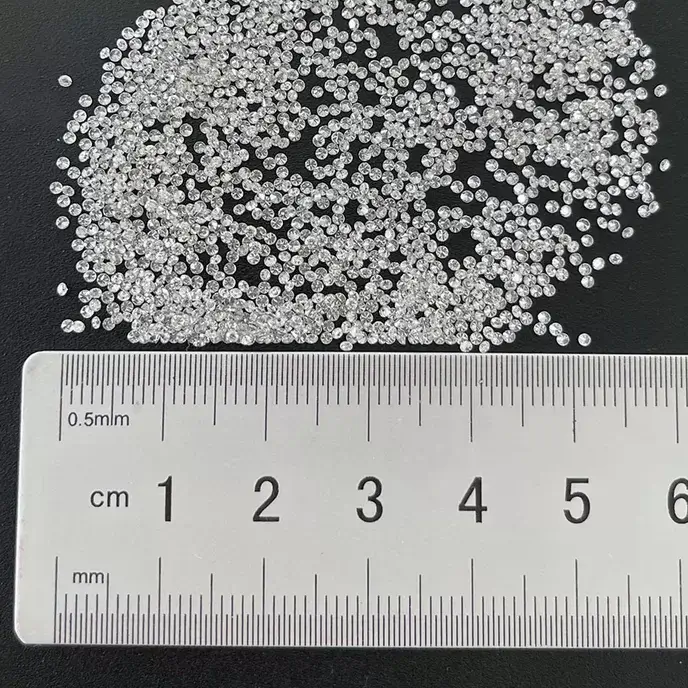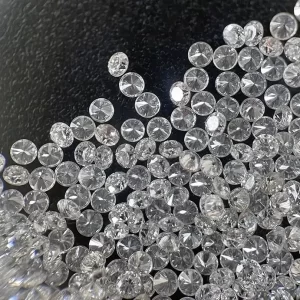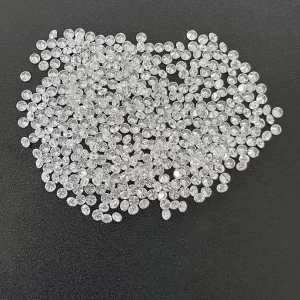The State of the Lab Grown Melee Diamond Industry
A JCK Las Vegas panel said the industry should not expect lab created diamond producers to fill a demand gap that natural diamond producers are already experiencing. CVD technology has made it cheaper for growers to produce larger stones. The JCK Las Vegas panel discussed this issue during the seminar, “The State of the Lab-Grown Diamond Industry.”
GIA
The Gemological Institute of America (GIA) recently received a package containing one natural diamond and 1,000 lab-grown melee. These melee stones totaled 9.67 carats, with one natural stone weighing about 1.7 carats. The GIA received a list of possible stones from the package, which it sorted by color, size, and cut. Of these, 1,093 stones were confirmed as GIA lab-grown melee diamonds, whereas nine stones fell outside of the screening criteria.
GIA scientists developed the operating principles for fancy-shaped melee screening and laser technology. They tested the prototype and developed a fully automated system. The entire process took about three years, and this new system will require less natural diamonds to be screened. GIA scientists will be able to tell which melee is a genuine diamond and which one is not. GIA lab-grown diamonds are a safer option for jewelry shoppers, because the GIA certification guarantees a genuine diamond.
In addition to being GIA-certified, GIA-lab-grown melee diamonds are widely used in various types of prong fancy settings. These diamonds add sparkle, volume, and all-around shine to jewelry. Popular melee diamond ring settings include pave, channel, and halo. Because these diamonds are grown using organic methods, their physical properties are the same as those of earth-mined diamonds.
ALROSA
Despite the popularity of lab grown diamonds, the natural diamond industry is experiencing problems sourcing melee. According to a panel at JCK Las Vegas, the biggest problem is Russia’s conflict with Ukraine, which has frozen the supply of diamonds. In the past 15 days, more than 250,000 workers have been put on paid leave at Surat’s diamond polishing units. This is a major setback for the world’s biggest diamond miner, Alrosa, which is partially owned by the Russian government. In addition, supplies of Alrosa have been frozen due to the conflict in Russia and Ukraine.
ALROSA, which is part-owned by the Russian government, has also been producing an increasing amount of these gems. It produces a large supply of 0.009-carat melee. But it also produces stars and smaller stones, ranging from 0.009 to 0.021 carats. So, in the coming years, lab grown melee will be a major competitor in the global diamond market.
The company’s AMS2 device has been designed to screen natural melee-size diamonds. It’s designed to screen stones for simulants and synthetics and is portable and more affordable than other methods. This device can screen up to 3,600 stones in an hour, and it can distinguish between natural and synthetic diamonds. Users include jewelry manufacturers and large chain retailers. It has been used in the diamond industry since the 1960’s.
GIA’s automated screening machine
A new automated screening machine from GIA will soon begin testing lab-grown melee diamonds. The AMS can detect stones that are not diamonds by using three different optical detection methods. Several of these machines can test individual stones, while others are designed to screen thousands of stones simultaneously. Some of these machines can examine mounted stones, while others test dozens of diamond-studded jewelry pieces.
The GIA’s new automated screening machine for lab-grown melee diamonds sorts and separates stones into natural, HPHT-treated, and simulants. The machine is capable of sorting round melee by size and color range, and the sorted stones are then returned to the client. This process will ensure that only natural diamonds are in the supply chain. GIA’s automated screening machine is a significant advance over current methods.
The machines will be operated by bourses and will collect data on the stones sold to the public. The GIA will then use this data to better understand the properties of synthetic diamonds. The undisclosed mixing of synthetics with natural diamonds has been a problem for several years. In spring 2012, an international gemological institute found hundreds of synthetic diamonds. The automated screening machine should help GIA better understand how synthetics are produced.
GIA’s new automated screening machine for lab grown melee diamond analysis will be able to analyze polished round diamonds ranging from one to 3.8 millimeters in diameter. It can sort 4,000 stones per hour, and takes 18 microseconds to collect 14 high-precision measurements of each diamond. This machine will be able to tell the difference between natural and lab-grown diamonds, as well as HPHT-treated diamonds. In addition to the ASDI machine’s advanced technology, it is also customizable in terms of size.
GIA’s labs
The Gemological Institute of America has a new service for analyzing lab grown melee diamonds, a relatively new method that allows the GIA to differentiate natural and synthetic melee. Since its inception, the GIA has tested millions of small round diamonds. Its lab grown melee service is the first of its kind, and has proven to be highly effective in identifying fake diamonds. Moreover, the service can sort and analyze melee diamonds, which means that consumers can be certain that the stones they are purchasing are genuine.
GIA has been grading lab grown diamonds since 2007, though the reports were different from those issued for mined diamonds. Until recently, lab grown diamonds only had a color and clarity range, but not their origin. Now, the GIA is considering adding this information to their reports, but until then, these diamonds are not guaranteed to be natural. Additionally, these lab grown diamonds may not have the same clarity and color characteristics as their mined counterparts.
While purchasing melee lab diamonds can be done at a jeweler, it is best to look for them online. Online manufacturers of diamonds provide excellent choices, affordable prices, and 100% satisfaction guarantees. Because of their popularity, GIA’s certification can help customers make an informed decision. In addition, these diamonds can be used in jewelry and other consumer products, such as watches, and are a valuable investment.
GIA’s phosphorescence test
The GIA’s phosphorescence testing on lab grown Melee diamonds is the gold standard for diamond authenticity. The method detects the presence of fluorescence when exposed to a special light. Because lab-grown Melee diamonds are so tiny, handling them is a challenge. The GIA has developed two different methods to detect these diamonds. The Sherlock Holmes CVD and HPHT detector by Yehuda Diamonds and the D-secure and J-secure Plus from DRC Techno, an Indian gemological research firm, offer these methods for free.
Because of the differences between lab-grown and natural diamonds, GIA’s testing process is more rigorous than a consumer can perform at home. The GIA uses sophisticated scientific equipment to determine the purity and color of lab-grown diamonds. The company’s automated synthetic diamond detector makes it easier to verify the authenticity of a lab-grown diamond. Its lab-grown diamond reports will also show its 4Cs evaluation and its proportions diagram.
Another important indicator of a lab-grown diamond is phosphorescence. This cool phenomenon occurs when a diamond is exposed to ultraviolet light. Most HPHT-grown diamonds exhibit some degree of phosphorescence. It is an important distinguishing factor between lab and natural stones. Some CVD-treated stones also exhibit phosphorescence, but the effect is less common. Phosphorescence is not recorded on GIA reports, and the GIA does not list a gemstone that exhibits phosphorescence.
GIA’s CVD process
Lab grown melee diamonds are created using the same process as other lab-grown gems. This process is also known as chemical vapor deposition or CVD. This process involves a vacuum chamber that contains a mix of gases in an atmosphere that is designed to deposit the material in a diamond’s crystal structure by plasma or heat. It is the process of choice for lab grown diamonds, which are 99% similar to natural diamonds.
When a piece of jewelry is purchased, buyers can trust the GIA’s grading report, which will feature the 4Cs assessment and plotted proportions diagram. Lab-grown stones will still carry GIA’s patented Diamond Transparency Certification (DTC) number, but they will also feature a disclaimer that says that the stone has been treated with post-growth treatment. The fee structure is the same as natural diamond reports. GIA’s lab grading laboratory in New York reopened Monday after a coronavirus outbreak forced it to close for six weeks.
Lab-grown melee diamonds are often used in jewelry. Their size can range from 0.001 to 0.2 carats, but they are worth their weight in gold. These diamonds are used in a variety of settings, such as cluster, pave, channel, and halo. Their unique sparkle makes them popular in jewelry collections. They are also inexpensive, as they cost as much as 30%-50% less than natural diamonds and can come in a variety of shapes and sizes.
1mm 0.005ct To 0.008ct Lab Grown Melee Diamonds Excellent Cut DEF VVS VS
















